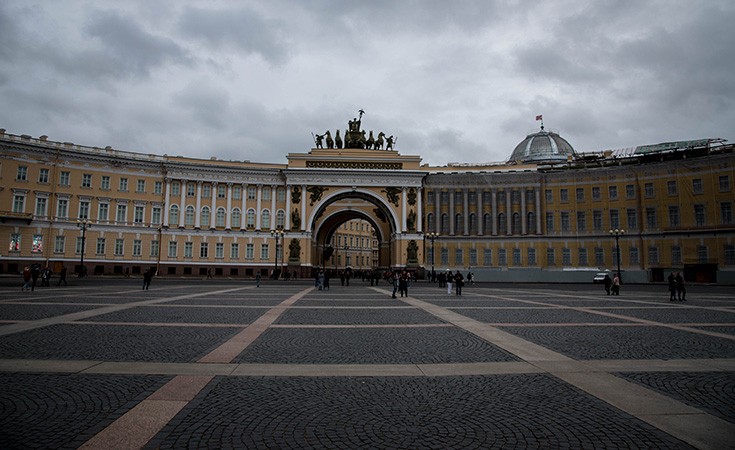
The Palace square is the main square in Saint Petersburg. The first building ever built on this square was the Winter Palace, built between 1754 and 1762 by Italian architect Francesco Rastrelli. The Winter Palace is a prominent building, open to visits, because it was the royal residence of the Russian Tsar and his family. The idea of Catherine the Great to build a monumental building on the opposite size of the Winter Palace that would be worthy of the royal capital was soon embraced. Architect Carlo Rossi realized this daunting project and the GENERAL Staff Building was built any time soon (from 1819 to 1829).
The General Staff Building has a semicircular façade and a picture perfect triumphal arch. On the top of the arch, there is The Chariot of Glory drawn by six horses in reins that were hitched side by side The works on the Palace Square were finally completed once the Alexander Column had been constructed. This monument is one of the highest monuments in the world. It is 47.5 meters tall and its weight is 600 tons. The column is made from a single boulder of red granite. This is the art of work of French architect Augusta Monterrand (he was also a chief architect involved in a project of building Isaac Cathedral in Saint Petersburg), built between 1830 and 1834. On top of the column, there is a statue of an angel holding a cross which points to the sky with his right hand. The figure of an angel was sculpted by Boris Ostrovsky.
The Palace square was the very place where a number of festivals and cultural events were organized. However, there were several less pleasant events that occurred which caused the deaths of countless Russian civilians. In 1879, Alexander Soloviev (a Russian student and a revolutionary) tried to assassinate Tsar Alexander II by firing five shots on the emperor. The attempt was a failure and Soloviev was hanged shortly afterwards (on May 28th 1879). The most tragic event on this square happened on January 22nd in 1905 when protesters, led by an Orthodox Christian priest George Gapon, wanted to hand over their petition to the emperor. The protesters demanded that the war with Japan be stopped, the voting rights be introduced and exercised and the rights of the workers be improved. Tsar Nicolay, at the time, left the Winter Palace and went to the Tsar Village while the police forcibly crushed the demonstrations. In this conflict, where protestors were unarmed, approx. 1000 people were wounded or killed. The utter chaos contributed to this tragic aftermath. This event was the cause of mass strikes throughout Russia and this is the reason why it is also considered the underlying cause of the first Russian revolution.
In 1924, a great chessboard was set on the square for a live match. Red Army soldiers and the Navy represented different figures in a game of chess and knights were soldiers on real horses. They played a match where moves were directed by the telephone. It was a memorable and superb game of chess
Today, this is still the main square of Saint Petersburg where many events are held such as New Year’s Eve celebration, the Victory day (9th of May), White Nights Festival etc.
Translation support - angloland
